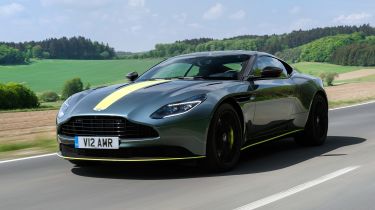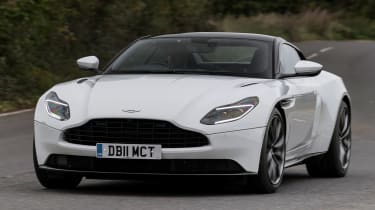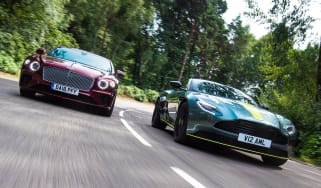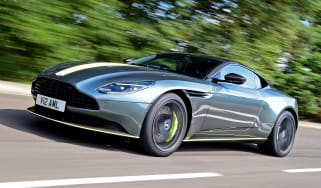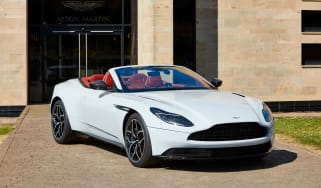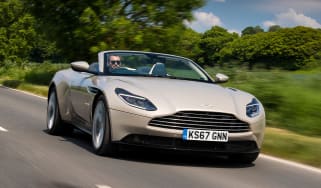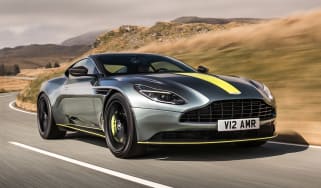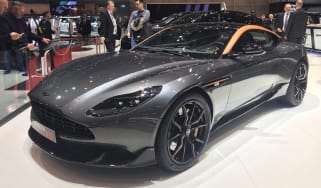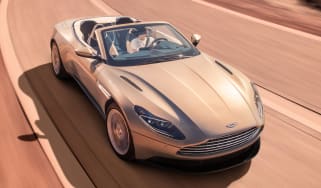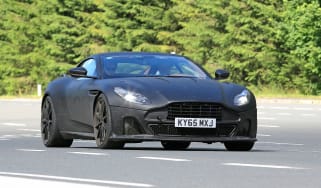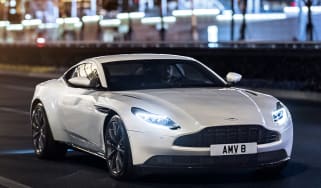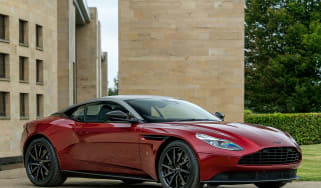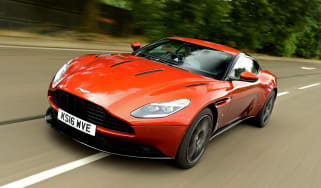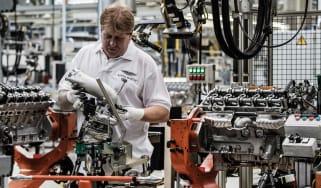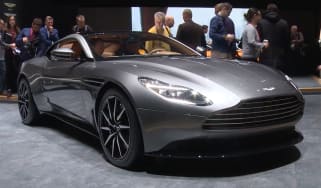Aston Martin DB11 (2017-2023) review
The Aston Martin DB11 is an old-school grand tourer that blends gorgeous looks with blistering performance and surprising comfort

The Aston Martin DB11 is the brand’s first all-new car in nearly 14 years. Heavily influenced by the DB10 that starred in the James Bond movie Spectre, the DB11 sets the tone for future Aston Martin models. The DB11 isn't just a pretty face, either, as the flowing lines hide clever aerodynamic additions that both deliver downforce and reduce drag.
Yet, it’s the way the car rides and handles that really impresses. It’s claimed to be the softest Aston yet, meaning it flows over bumps with a supple poise that its predecessor can’t match. However, this comfort doesn’t affect the handling, as the DB11 displays remarkable agility and control for a car that tips the scales at over 1,800kg.
The cabin mixes cutting-edge style and electronics supplied by Mercedes, although some of the materials and finish are some way short of the likes of the Bentley Continental or even the Audi R8. Cramped rear seats and hefty running costs also count against the DB11, but for many buyers the car’s ravenous thirst for fuel won’t be a problem.
Besides, that doesn't detract from the DB11 being one of the fastest and most desirable long-distance cruisers money can buy.
The Aston Martin DB11 is the replacement for the long-running DB9, and it brings up-to-date technology to Aston's range of large-capacity grand tourers. At the top of the range, power still comes from a V12 engine, but the 5.2-litre unit is a brand-new design that features twin turbos to give the car 600bhp and 700Nm of torque. It's mated to an eight-speed auto gearbox mounted on the transaxle, and as a result performance is electric, with the 0-62mph sprint taking just 3.9 seconds.
Used - available now

2023 Ford
Puma
19,715 milesManualPetrol1.0L
Cash £16,200
2021 Vauxhall
Crossland
10,677 milesAutomaticPetrol1.2L
Cash £14,000
2021 Kia
Sportage
27,592 milesManualPetrol1.6L
Cash £15,400
2022 Toyota
C-HR
32,000 milesAutomaticPetrol1.8L
Cash £20,490Although it only went on sale in 2016, Aston replaced the V12 DB11 with the DB11 AMR in 2018. This features the same V12 engine, but with 630bhp instead of 600bhp. Tweaked dampers, gearbox settings and a new exhaust also feature in the AMR, together with extra carbon fibre on the bonnet, sills and cabin.
For even more performance, Aston Martin sell a DBS Superleggera version which manages to eke a staggering 715bhp and 900Nm from the same V12 engine. There's also a DB11 V8, which is substantially cheaper to buy. And, although, it loses out to the V12 in many ways - it only develops a 'mere' 503bhp and 685Nm of torque, for example - we think it's a better model overall.
Fans of luxurious drop tops, meanwhile, are taken care of by the soft-top DB11 Volante. Available only with the V8 engine, the Volante sacrifices little in the way of performance to its coupe stablemate, while the addition of a folding roof does little to spoil the car's flowing lines.
As well as new engines, the DB11 uses an all-new platform that will be used on a number of Aston's next models, including the 2018 Vantage and the DBX crossover. The new structure is far stiffer than before, but while it features plenty of aluminium in its construction, the DB11 still weighs over 1,800kg.
In whatever guise you opt for, the DB11 has a lot of power. To transmit its performance to the road, the DB11 has an advanced chassis featuring sophisticated multi-link rear suspension, double wishbone up front and standard-fit adaptive dampers. AMR and DBS versions share a similar set up, but with the dampers, suspension bushes and anti-roll bars tightened up.
Aston Martin's twin-turbo 5.2-litre V12 is smaller than the 6.0-litre unit in the DB9, but it's more powerful. Peak power was 600bhp in the DB11 V12, but now stands at 630bhp in the DB11 AMR, while both cars have 700Nm of torque available from as low as 1,500rpm.
That's a lot of power to put to the Tarmac, but the DB11's new chassis features a sophisticated multi-link rear axle set-up, double wishbones up front and standard-fit adaptive dampers, with the dampers, suspension bushes and anti-roll bar tightened up for the AMR version.
Aston claims that the DB11 is the softest Aston ever, but while it's very comfortable, the dampers can control wheel movement, so the DB11 still delivers sharp and agile handling.
On the outside, the DB11 takes inspiration from James Bond's exclusive DB10, and it's easily recognisable as an Aston, with a low-slung shape, long bonnet and short rear end. But the lines are thoroughly modern, with sharp lines and plenty of design features to turn heads, while also providing aerodynamic efficiency to keep the car glued to the road without the need to add ungainly wings to the elegant bodywork. Aston also offers a range of personalisation options for customers, so buyers can tailor their car to their desires.
That personalisation carries over to the cabin, which is hand-made and features plenty of wood and leather, as you would expect. What you might not expect is the Mercedes-sourced switchgear that's used in the cabin. Aston has signed up with Mercedes to provide the electronic systems, so you get Merc's Comand control wheel on the centre console, as well as its familiar single-stalk wiper/light control behind the steering wheel. However, these parts are well integrated and don't detract from the Aston's high-class finish.
With prices starting not far short of £150,000, there aren't many rivals for the Aston Martin DB11, but they do exist. Chief among these is the Bentley Continental GT, which delivers the same kind of luxury and performance that a hand-built British grand tourer can manage. Elsewhere, the Mercedes S-Class Coupe is an upmarket alternative that also has V12 power in AMG 65 guise, while the Ferrari GTC4 Lusso is another front-engined GT, although one that costs nearly twice as much. Another pricey alternative is the Rolls-Royce Wraith.
Engines, performance and drive
The DB11 is the first Aston to use the brand’s downsized V12 engine. However, any fears that a reduction in capacity – down from 6.0 to 5.2 litres – would lead to a drop in performance are unfounded. Thanks to the addition of a pair of turbochargers, the new unit pumps out a heady 600bhp (630bhp for the DB11 AMR) and a thumping 700Nm of torque.
The DBS Superleggera model screws even more power out of the V12, with 715bhp and 900Nm of torque and, as with its DB9 predecessor, all DB11s gets a traditional rear-wheel drive layout and a transaxle gearbox location. This means the eight-speed auto is mounted between the rear wheels, helping Aston’s engineers achieve a near-perfect 50/50 weight distribution.
As with its DB9 predecessor, the DB11 gets a traditional rear-wheel drive layout and a transaxle gearbox location. This means the eight-speed auto is mounted between the rear wheels, helping Aston’s engineers achieve a near-perfect 50/50 weight distribution.
Yet it’s the changes to the car’s structure and suspension that are really impressive. Aston has poached a number of chassis engineers from fellow British firm Lotus, and it’s clear their efforts have paid off, because the DB11 manages to handle with remarkable agility, yet it also soaks up bumps as effortlessly as an executive saloon.
This newfound composure can partly be traced to the brand’s new scalable extruded and bonded aluminium architecture, which is far stiffer than the old VH platform used by the DB9, Vantage, Vanquish and Rapide. This allows the suspension geometry to work more consistently.
At the front is a traditional double wishbone set-up, while at the rear is an all-new multi-link axle. Adaptive dampers are standard, as is an electric power steering set-up.
Drivers can choose from three separate driving modes – GT, Sport and Sport+. Even in GT, the Aston feels remarkably poised and agile. The steering is quicker than in the DB9, but it never feels nervous or edgy, like in a Ferrari F12. The electrically assisted set-up is also naturally weighted and delivers just the right amount of feedback for a fast GT car.
As a result, the Aston responds quickly to inputs and can be placed with pinpoint accuracy. There’s plenty of bite from the front tyres and the Aston clings tightly to your chosen line, despite the fact that the torque vectoring system doesn’t start working until fairly high cornering forces are detected.
There’s also remarkably little roll through corners, while body movements are well checked even when the dampers are in their softest setting. Selecting Sport or Sport+ mode ties the car down a little more – it also adds weight to the steering, sharpens the throttle respones and changes the gearshift strategies – but for most people most of the time, GT will feel like the best judged setting.
As you’d expect from a car with so much power and rear-wheel drive, the DB11’s line through a corner can be influenced as much by the throttle as the steering.
Even with the stability control switched on, you can feel the car’s balance being altered by a sudden application of power. Sport+ mode relaxes the electronic safety net to allow a little slip on the exit of corners, meaning you can enjoy the car’s natural balance without fear of the situation getting out of hand.
The DBS Superleggera is even easier to unsettle with easily enough torque to overcome the huge Pirelli P Zero tyres. Unless you’re on a perfectly smooth bit of road without any camber, anything approaching full throttle will cause the Superleggera to squirm as the traction control fights to maintain order.
What may surprise you is that less is more in the DB11. The V8-engined model isn't as heavy as the V12 car, so it feels lighter on its toes, more nimble and alert to inputs from the steering. And, when you get to a corner, the lighter front end tucks in more quickly and with more precision.
Of course, the DB11 is a GT car first and foremost, so it needs to be as relaxing when you don’t want to drive like your hair is on fire. Leave the car in GT mode and the suspension does a remarkable job of soaking up bumps. Deeper potholes and sharp ridges are felt, but that’s largely to do with the massive 20-inch alloys.
It’s fairly refined, too, so you’ll be more than comfortable enough covering huge distances in the DB11. The soft-top DB11 Volante loses just a tenth of a second to the V8 coupe in the 0-62mph dash, while the absence of a fixed roof does little to harm overall driving dynamics.
Engines
There are only two engines available, but they're both crackers. The range-topping 5.2-litre V12 is smaller than the old 6.0-litre unit in the Aston DB9, but the addition of a pair of turbochargers means that there’s a stonking 600bhp available at 6,500rpm, rising to 630bhp at the same rpm for the DB11 AMR and 715bhp for the DBS Superleggera. More impressively, there’s a rippling 700Nm of torque for the lower-powered models and a hefty 900Nm for the DBS.
As you’d expect, performance is blistering. Aston claims the V12 DB11 will blast from 0-62mph in just 3.9 seconds, before thundering on to a supercar-baiting top speed of 200mph. The DB11 AMR model deals with 0-62mph in 3.7 seconds and pushes the top speed to 208mph. DBS models improve on this further with a 0-62mph time of 3.4 seconds and a top speed of 211mph.
These figures look good on paper, but the Aston feels even more impressive in the real world. Despite being the brand’s first turbocharged unit, the engine feels almost naturally aspirated in its delivery. There’s virtually no turbo lag and it pulls strongly from just above idle all the way round to the 7,000rpm redline. The powerplant’s linear delivery means that there’s no sudden rush of acceleration; it simply gathers speed deceptively quickly.
Turbochargers often muffle an engine’s natural exhaust note, but happily Aston has paid careful attention to the DB11’s soundtrack. Press the starter button and the V12 erupts noisily into life – although there is the option of a quieter start if you don’t want to annoy the neighbours when you need to make an early morning getaway.
At low revs the engine emits a purposeful growl, while working the unit hard results in Aston’s trademark howl. It’s not as loud as a Ferrari V12, but it’s noisy enough and packed with character. More importantly, it’s all-natural, as Aston’s engineers didn’t want to use sound generators that boost the noise by playing it through the stereo’s speakers.
The eight-speed automatic gearbox shifts smoothly when left to its own devices, yet delivers quick and crisp manual changes via the tactile aluminium paddles mounted on the steering wheel. The speed and ferocity of the shifts can be altered by engaging he Sport and Sport+ driving modes, but as with the steering and throttle, GT is the set-up you’re likely to use most of the time.
The only alternative engine to the V12 is a 4.0-litre turbocharged V8. And, while it's less powerful than the V12, with 503bhp and 685Nm of torque, you don't notice a huge amount of difference on the road. In fact, it's only a tenth of a second slower to 60mph than the original DB11 V12, and because the V8 car is lighter, it feels more nimble and responsive.
To cap it all, it also has a much more aggressive exhaust note than the V12 (though the DB11 AMR features a fruitier note than the V12 it replaced), which ramps up in ferocity when you cycle through the GT, Sport and Sport+ driving modes.
MPG, CO2 and Running Costs
Aston has chosen to downsize its trademark V12 engine and introduce a V8 in an effort to boost efficiency. However, while the twin-turbocharged 5.2-litre V12 unit uses less fuel and emits less CO2 than the old naturally aspirated engine in the DB9, you’d struggle to call it frugal.
Despite the addition of stop/start technology, the DB11 V12 will return around 24mpg and emit 270g/km of CO2 on the combined cycle, or 24.8mpg and 265g/km for the DB11 AMR. And, given the car’s enormous performance potential, it's likely that hard use will soon see your fuel consumption dip into single figures. The V8 is a little better, with an official average of 28.5mpg, but again, if you use its power to the full, you won't get anywhere near that.
However, you don’t buy a V8- or V12-engined Aston Martin to save on your motoring bills, so this is unlikely to put off potential buyers. Even so, it’s worth keeping in mind the other costs likely to be incurred if you make the most of the Aston’s performance. Despite the car’s aluminium core, it still tips the scales at 1,770kg. As a result, hard use will result in heavy brake and tyre wear, particularly if you take your DB11 on track.
Insurance
British security and insurance experts Thatcham haven’t yet released grouping data for the DB11. However, given the car’s performance potential, relatively high value and hi-tech engineering it’s safe to say it won’t be a low rating.
That said, all models get a Thatcham category one alarm and immobiliser, but there’s also standard tracking device – you’ll have to pay an annual subscription fee to its service provider.
Depreciation
Our experts haven’t yet calculated residuals on the DB11, but its predecessor, the DB9, is currently hovering around 40 per cent of its new value after three years and 36,000 miles. We’d expect the DB11 to perform more strongly than this, certainly early on when demand for the car is strong and the available numbers are low.
This is certainly likely to be the case for the first cars, with second-hand prices likely to exceed new as eager customers try to avoid a lengthy waiting list for what is likely to be a sought after car.
To get an accurate valuation on a specific model check out our free car valuation tool...
Interior, design and technology
The DB11 is one of Aston Martin’s most daring models to date, but the brand has also been careful not to mess with a winning formula. As a result, you get the familiar Aston grille at the front, together with the firm’s trademark proportions. This means the long bonnet, sweeping roofline and short rear overhang are all present and correct.
However, there are some clever aerodynamic touches integrated into the DB11’s sleek and flowing lines, the most innovative being the Airblade system. This set-up funnels air into channels set into the C-Pillar, then feeds it into outlets just above the tailgate. This stream then meets with air flowing over the small, powered spoiler. Aston claims the system boosts downforce while also reducing drag.
The DB11 also features an all-LED lighting set-up. At the front are a pair of swept back headlamps, while at the rear are distinctive tail lamps that Aston claims are the thinnest on any production car.
The DB11 AMR features dark surrounds for the headlights, smoked finishers for the exhausts, plus carbon-fibre details on the bonnet, sills and interior. The DBS looks similar, with little more than a different colour scheme and a fresh set of alloys to set it apart from the rest of the range.
The DB11 also features an all-LED lighting set-up. At the front are a pair of sweptback headlamps, while at the rear are distinctive tail lamps that Aston claims are the thinnest on any production car.
The DB11 AMR features dark surrounds for the headlights, smoked finishers for the exhusts, plus carbon-fibre details on the bonnet, sills and interior.
Go for the DB11 Volante and its fabric roof folds at speeds up to 30mph, and tucks neatly away behind the cabin under an impressively low-slung deck lid.
All versions of the DB11 get 20-inch alloys as standard, while there’s a wide range of paint options available. Aston Martin also has its bespoke Q service that will tailor a car to your specific needs. At a cost, of course.
Perhaps the biggest leap forward has occurred inside, as the DB11 is the first model to benefit from Aston Martin’s recent tie-up with Mercedes Benz. Essentially the car’s whole electrical architecture has been carried over from the German firm, which means Aston has access to the latest infotainment and sat-nav technology.
It also means that this is the first Aston in almost three decades that doesn’t feature a cabin that’s littered with hand-me-down components from Ford and Volvo. There are some recognizable Mercedes parts, such as the rotary infotainment controller and the single stalk for indicators and wipers, and some Aston buyers will be disappointed that those items aren't bespoke.
The rest of the interior is a mix of tech and tradition. For instance, the driver benefits from a customisable TFT screen instead of traditional dials, while the sat-nav map is displayed in a classy-looking tablet-style screen on top of the dash.
Yet, there’s also plenty of hand-stitched leather and the option of glossy real wood finishes. However, the quality of some of the materials isn't up to the standards of Bentley or German rivals - especially some of the metal-effect finishes that look a little cheap, most notably on the door panels.
There’s loads of standard kit on board, though, plus some quirky touches, such as the powered lid for the transmission tunnel cubby. Press a button and it glides open to reveal a pair of cupholders and sockets for smartphones. However, in our test car, its operation was a little noisy and arguably it's one of the least necessary electric motors we've come across in a car!
Sat-nav, stereo and infotainment
A big benefit of Aston Martin’s recent partnership with Mercedes is that it now has access to some up to date infotainment systems. The creaky and difficult to use Volvo-sourced units used in the DB9 are now a distant memory.
The DB11’s sat-nav and stereo functions are accessed using Mercedes’ familiar rotary COMAND controller. The unit is set at the base of the centre console and is neatly integrated enough that you’d never know it’d come from a Merc. It controls a tablet-style screen set on top of the dashboard. This unit is easy to navigate and features crisp graphics.
As with its other models, the DB11 is available with an eye-wateringly expensive Bang & Olufsen sound system, the highlight of which is the dash top-mounted tweeters that rise up when the stereo is switched on.
Practicality, comfort and boot space
The Aston Martin is designed as a fast and elegant GT car, meaning it’s surprising practical for a model with supercar-slaying performance.
Aston’s new scalable aluminium architecture has actually allowed the brand’s designers to create more interior space within an external footprint that isn’t much larger than the old DB9’s. Like its predecessor, it features a 2+2 seating layout, plus a boot that’s big enough to deal with a lengthy trip away.
Access to the cabin is fairly straightforward thanks to long doors that open wide, while the driver and passenger get lots of head- and legroom. There’s also a wider range of seat adjustment than ever before, meaning it’s easier for taller drivers to get comfortable. The electrically adjusted seats also provide plenty of support, both when cornering hard and when travelling long distances.
However, the individual rear seats are really only suitable for small children, as there’s very little headroom and virtually no space for legs.
Opening the boot reveals a well-shaped, large luggage area, which offers 270 litres' worth of space. It’s more than capable of accommodating larger suitcases, meaning the DB11 is well up to the task of taking its well-heeled occupants and their luggage on cross-continental dashes to their holiday hones by the Med. Note the convertible Volante can only store 224 litres in its boot - though Aston says it'll swallow two sets of golf clubs.
Reliability and Safety
The DB11 is an all-new car for Aston Martin, so it’s difficult to predict how robust it will be. However, the 5.2-litre engine is based on tried and tested technology that Aston has been developing for decades. Also, the company has received plenty of investment in recent years, with much of the money being ploughed into research and development.
Elsewhere, many of the Aston’s components have been bought in from trusted suppliers. The eight-speed gearbox is from respected brand ZF, while all of the car’s electrical systems are from partner firm Mercedes.
Given the DB11’s focus on performance, it’s no surprise to find the car’s safety systems are up to scratch. Six airbags are fitted as standard, while the stability control has a setting that allows a little bit of fun before reining in any wayward behavior. Of course, it’s also possible to turn the systems off completely.
Other additions that come courtesy of Mercedes include the adaptive cruise control and lane departure warning systems.
Powerful brake discs are clamped by six-pot calipers, giving the Aston strong and relatively fade-free stopping. There are currently no plans to add a carbon ceramic disc option.
Like all Aston models, the DB11 is covered by a standard three-year, unlimited-mileage warranty, which can be extended by a further two years at extra cost. This extra guarantee can be upgraded to Plus, Premium or Classic level depending on your needs and budget. And, if you're lucky enough to get one of the first 1000 cars, it will have been hand inspected and signed by Aston President and CEO Andy Palmer.
There currently aren’t any servicing prices or intervals for the DB11, but regularly maintenance is unlikely to be cheap.
